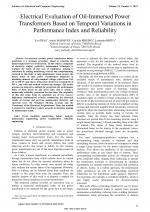| 3/2023 - 2 |
Electrical Evaluation of Oil-Immersed Power Transformers Based on Temporal Variations in Performance Index and ReliabilityDIAS, Y. |
| Extra paper information in |
| Click to see author's profile in |
| Download PDF |
Author keywords
condition monitoring, failure analysis, maintenance engineering, power transformers, reliability engineering
References keywords
power(13), transformers(12), insulation(10), analysis(7), interpretation(5), insulating(5), marques(4), guide(4), dielectric(4), dias(4)
Blue keywords are present in both the references section and the paper title.
About this article
Date of Publication: 2023-08-31
Volume 23, Issue 3, Year 2023, On page(s): 13 - 20
ISSN: 1582-7445, e-ISSN: 1844-7600
Digital Object Identifier: 10.4316/AECE.2023.03002
Web of Science Accession Number: 001062641900002
SCOPUS ID: 85172334203
Abstract
In electrical systems, power transformer failure prediction is a strategic procedure aimed at ensuring the uninterrupted delivery of electricity. In this context, companies of electricity employ predictive maintenance techniques to evaluate the status of this type of equipment. Aiming to contribute by adding monitoring criteria and complementing research in this field, to help maintenance teams project the future status of their power transformers immersed in insulating mineral oil with nominal voltages rated from 34.5 kV to 230 kV and above, with powers from tens to hundreds of MVA, and with and without on-load tap changer, this article presents an innovative method for projection the performance index of these assets on any given date, and to obtain a numerically reliability projection for that date. The originality of this tool stems from its combined use of two easy-to-implement mathematical criteria, considering the historical results of current and previous maintenance dielectric and electrical tests: the Weighted Moving Average and the Consistency of the Historical Neighborhood. Thus, this method is expected to contribute to more accurate to decisions making by maintenance teams. |
| References | | | Cited By |
Web of Science® Times Cited: 0
View record in Web of Science® [View]
View Related Records® [View]
Updated 2 days, 18 hours ago
SCOPUS® Times Cited: 1
View record in SCOPUS® [Free preview]
View citations in SCOPUS® [Free preview]
[1] Calculation of power transformer health index using the combination of principal component analysis and mass-spring-damper model, Zeinoddini-Meymand, Hamed, Saeid, Morteza, Vahidi, Behrooz, Electrical Engineering, ISSN 0948-7921, 2024.
Digital Object Identifier: 10.1007/s00202-024-02459-9 [CrossRef]
Disclaimer: All information displayed above was retrieved by using remote connections to respective databases. For the best user experience, we update all data by using background processes, and use caches in order to reduce the load on the servers we retrieve the information from. As we have no control on the availability of the database servers and sometimes the Internet connectivity may be affected, we do not guarantee the information is correct or complete. For the most accurate data, please always consult the database sites directly. Some external links require authentication or an institutional subscription.
Web of Science® is a registered trademark of Clarivate Analytics, Scopus® is a registered trademark of Elsevier B.V., other product names, company names, brand names, trademarks and logos are the property of their respective owners.
Faculty of Electrical Engineering and Computer Science
Stefan cel Mare University of Suceava, Romania
All rights reserved: Advances in Electrical and Computer Engineering is a registered trademark of the Stefan cel Mare University of Suceava. No part of this publication may be reproduced, stored in a retrieval system, photocopied, recorded or archived, without the written permission from the Editor. When authors submit their papers for publication, they agree that the copyright for their article be transferred to the Faculty of Electrical Engineering and Computer Science, Stefan cel Mare University of Suceava, Romania, if and only if the articles are accepted for publication. The copyright covers the exclusive rights to reproduce and distribute the article, including reprints and translations.
Permission for other use: The copyright owner's consent does not extend to copying for general distribution, for promotion, for creating new works, or for resale. Specific written permission must be obtained from the Editor for such copying. Direct linking to files hosted on this website is strictly prohibited.
Disclaimer: Whilst every effort is made by the publishers and editorial board to see that no inaccurate or misleading data, opinions or statements appear in this journal, they wish to make it clear that all information and opinions formulated in the articles, as well as linguistic accuracy, are the sole responsibility of the author.





